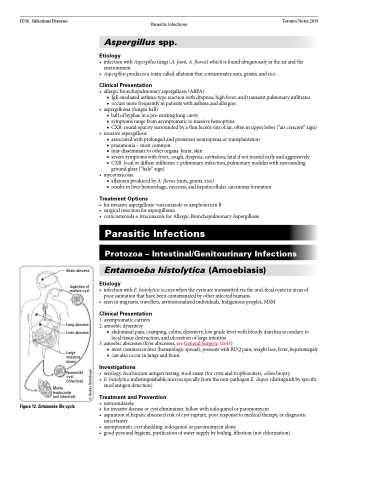Page 636 - TNFlipTest
P. 636
ID36 Infectious Diseases
Parasitic Infections Toronto Notes 2019 Aspergillus spp.
Etiology
• infectionwithAspergillusfungi(A.fumi,A.flavus)whichisfoundubiquitouslyintheairandthe environment
• Aspergillusproducesatoxincalledaflatoxinthatcontaminatesnuts,grains,andrice
Clinical Presentation
• allergicbronchopulmonaryaspergillosis(ABPA)
■ IgE-mediated asthma-type reaction with dyspnea, high fever, and transient pulmonary infiltrates ■ occurs more frequently in patients with asthma and allergies
• aspergilloma(fungusball)
■ ball of hyphae in a pre-existing lung cavity
■ symptoms range from asymptomatic to massive hemoptysis
■ CXR: round opacity surrounded by a thin lucent rim of air, often in upper lobes (“air crescent” sign)
• invasiveaspergillosis
■ associated with prolonged and persistent neutropenia or transplantation
■ pneumonia – most common
■ may disseminate to other organs: brain, skin
■ severe symptoms with fever, cough, dyspnea, cavitation; fatal if not treated early and aggressively ■ CXR: local or diffuse infiltrates ± pulmonary infarction, pulmonary nodules with surrounding
ground glass (“halo” sign) • mycotoxicosis
■ aflatoxin produced by A. flavus (nuts, grains, rice)
■ results in liver hemorrhage, necrosis, and hepatocellular carcinoma formation
Treatment Options
• forinvasiveaspergillosis:voriconazoleoramphotericinB
• surgicalresectionforaspergilloma
• corticosteroids±itraconazoleforAllergicBronchopulmonaryAspergillosis
Parasitic Infections
Protozoa – Intestinal/Genitourinary Infections
Entamoeba histolytica (Amoebiasis)
Etiology
• infectionwithE.histolyticaoccurswhenthecystsaretransmittedviatheoral-fecalrouteinareasof poor sanitation that have been contaminated by other infected humans
• seeninmigrants,travellers,institutionalizedindividuals,Indigenouspeoples,MSM
Clinical Presentation
1. asymptomatic carriers 2. amoebic dysentery
■ abdominal pain, cramping, colitis, dysentery, low grade fever with bloody diarrhea secondary to local tissue destruction, and ulceration of large intestine
3. amoebic abscesses (liver abscesses, see General Surgery, GS43)
■ mostcommoninliver(hematologicspread);presentswithRUQpain,weightloss,fever,hepatomegaly ■ can also occur in lungs and brain
Investigations
• serology,fecal/serumantigentesting,stoolexam(forcystsandtrophozoites),colonbiopsy
• E.histolyticaindistinguishablemicroscopicallyfromthenon-pathogenE.dispar(distinguishbyspecific
stool antigen detection)
Treatment and Prevention
• metronidazole
• forinvasivediseaseorcystelimination:followwithiodoquinolorparomomycin
• aspirationofhepaticabscessifriskofcystrupture,poorresponsetomedicaltherapy,ordiagnostic
uncertainty
• asymptomaticcystshedding:iodoquinolorparomomycinalone
• goodpersonalhygiene,purificationofwatersupplybyboiling,filtration(notchlorination)
Brain abscess
Ingestion of mature cyst
Lung abscess Liver abscess
Large intestine ulcers
Nonmotile cyst (infective)
Motile trophozoite (not infective)
Figure 12. Entamoeba life cycle
© Andrea Berenbaum


